Zurück
|
|
ABSOLUTER FILM - VIKING EGGELING |
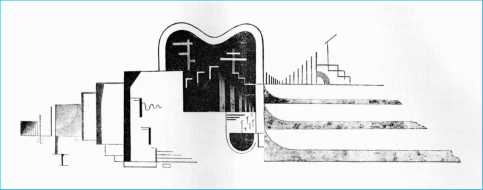 |
|
Horizontal-vertikal |
Viking
Eggeling
Helmuth
Viking Eggeling
(* 21.
Oktober
1880
in Lund;
† 19.
Mai
1925
in Berlin)
war ein schwedischer Dadaist
und Experimentalfilmer.
Diagonal-Symphonie
(1924)
Wie
auch Hans Richter interessierte sich Eggeling für den Film, um eine
"bewegte Malerei", eine "Bewegungskunst" zu schaffen und verfolgte die
Theorie, dass es für den Betrachter leichter und einprägsamer wäre,
wenn er die Veränderungen der Formen nicht in der Bewegung durch den
Raum erfahren würde, sondern ganz bequem im entspannten Sitzen. 1921
bis 1924 folgten weitere Filmexperimente und Versuche, eine filmische
Synthese aus Rhythmus, abstrakten Bildern, Bewegung und Musik zu
kreieren.
1923
entstand in den Universum Film (UFA)-Trickfilmateliers unter seiner
Leitung das Werk Diagonal-Symphonie, ein Stummfilm in Schwarz-Weiß mit
einer Länge von 7 ¾ Minuten. Hierbei benutzte er selbstentworfene
Bilder als Vorlagen, die er mit schwarzem Papier abdeckte und langsam
freilegte, indem er das Papier verschob oder Figuren ins Papier
schnitt. Der Film wurde 1924 fertiggestellt und am 3. Mai 1925 im
Rahmen der Matinee, „Der absolute Film“, öffentlich aufgeführt.
Sechzehn Tage später starb Eggeling.
Aufgrund
seiner musikalischen Zeiteinteilung sowie seiner auf
Hell-Dunkel-Kontrasten, Richtungsveränderungen und der aufbauenden
linearen Formdramatik aus Kurven, Linien, Harfen und Dreiecken übte
Eggelings Meisterwerk großen Einfluss auf Künstler wie László
Moholy-Nagy aus und gilt als der Urvater des heutigen Musikvideos.
Weblinks
 Commons:
Viking Eggeling –
Sammlung von Bildern, Videos und Audiodateien
Commons:
Viking Eggeling –
Sammlung von Bildern, Videos und Audiodateien


Viking
Eggeling
lebte
in Ascona von den Gemüsen, die er und seine kleine,
vernachlässigte Frau Marion im Garten des Hauses zog, das der
gütige 'Pelz-Meier' ihm in Ascona, gegen gelegentliche Bilder,
zur Verfügung gestellt hatte. Es war in der Tat keine
'Sommerfrische' für diesen merkwürdigen 'Christus' ...
(Hans Richter,
Dada Profile, Zürich 1961, S. 36)
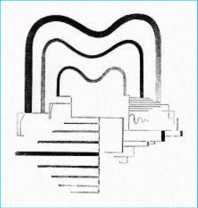  |
|
Basse genera! |
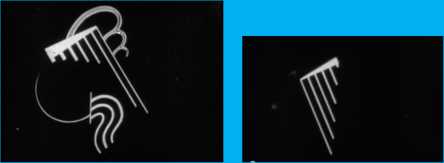 |
|
_E MUSIK |
Der
Schwede Viking Eggeling entwickelte 1917 in Ascona, zusammen mit dem
französischen Lyriker Yvan Goll, später mit dem Dadaisten Hans
Richter, die ersten abstrakten Filme.
|
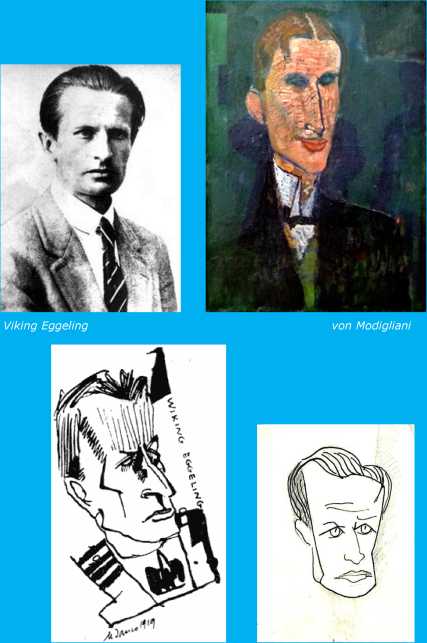
|
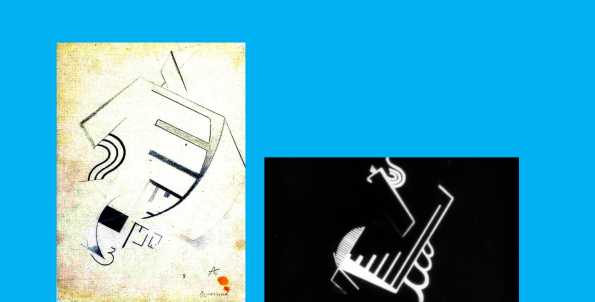
von
Marcel Janco
von Hans
Richter
|
Made in 1924 by Viking Eggeling, SYMPHONIE DIAGONALE is the best abstract film yet conceived. It is an experiment to discover the basic principles of the organization of time intervals
in the film medium.”
Frederick J. Kiesler
Viking Eggeling was
an avant-garde artist and filmmaker connected to Dada, Constructivism
and Abstract art and was one of the pioneers in absolute film and
visual music. His 1924 film Symphonie diagonale [Diagonal Symphony] is one of the seminal abstract films in the history of experimental cinema.
In
the years c1915-1917 he lived first at Ascona and later other places in
Switzerland, with his wife Marion, nee Klein. During this time, he
started working on his 'universal language', a theory of harmony
for painting which was to open up a way for meaningful communication
between viewer and artist.141
During one of his stays at the Mount Verita Lebensreform
colony at Ascona, Italy, Eggeling met the author Yvan Goll, one of the
principle advocates of film as art amongst German literary circles.
In 1920, Goll published the article entitled Das Kinodram where he
states emphatically that “the basis of all future art is the
cinema.” During 1918 Goll helped E ggeling with first preliminary works
for the latter’s abstract film (probably Horizontal-Vertikal-Messe)
cutting geometrical forms and mounting them onto the celluloid
support. According to Claire Goll, the two also discussed
the foundations of abstract film which Goll still called Kinomalerei [cinema-painting].*51
In
c1918 Viking and Marion settled down in Zürich. There he re-connected
with Jean Arp and took part in several Dada activities, befriending Marcel Janco, Richard Huelsenbeck, Sophie Taeuber, and the other dadaists connected to the Cabaret Voltaire. In March 1919 he also joined the group Das neue Leben [New Life], started the year before in in Basel by Arp, Fritz Baumann, Augusto Giacometti, Janco, Taeuber, and Otto Morach, among others.
In one version of his encounter with Eggeling, Richter said the following (in Richter, "Avant-Garde Film in ", 1949):
"I
spent two years, 1916-1918, groping for the principles of what made for
rhythm in painting. [...] In 1918, Tristan Tzara brought me together
with a Swedish painter from Ascona, who, as he told me, also
experimented with similar problems. His name was Viking Eggeling. His
drawings stunned me with their extraordinary logic and beauty, a
new beauty. He used contrasting elements to dramatize two (or more) complexes of forms and used analogies in these same complexes to relate
them again. In varying proportions, number, intensity, position, etc.,
new contrasts and new analogies were born in perfect order, until
there grew a kind of ‘functioning’ between the different form
units, which made you feel movement, rhythm, continuity... as clear as
in Bach. That’s what I saw immediately!"
Viking Eggeling lebte
in Ascona von den Gemüsen, die er und seine kleine, vernachlässigte
Frau Marion im Garten des Hauses zog, das der gütige ’Pelz-Meier’ ihm
in Ascona, gegen gelegentliche Bilder, zur Verfügung gestellt
hatte. Es war in der Tat keine ’Sommerfrische’ für
diesen merkwürdigen ’Christus’ ...
(Hans Richter, Dada Profile, Zürich 1961, S. 36)
|
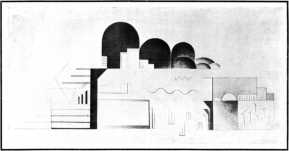 |


 Eggeling,
gebürtiger Schwede,
siedelte nach 1897 nach Deutschland über und studierte dort
neben seiner Arbeit als Bibliothekar
auch Kunstgeschichte
und Malerei.
Von 1907 bis 1911 wirkte er als Kunstlehrer am Hochalpinen Lyceum in
Zuoz/Institut Engiadina (heute Lyceum
Alpinum Zuoz)
in der Schweiz. Nach dem Ersten
Weltkrieg
ging er nach Zürich
und kam da mit der Dada-Bewegung in Berührung. Freundschaft mit
Hans
Richter,
Jean
Arp,
Tristan
Tzara
und Marcel
Janco.
1918 wurde er Mitglied in der Berliner Novembergruppe.
Anfangs beschäftigte er sich mit Rollenbildern,
d.h. mit Bleistift gezeichnete Variationen grafischer Elemente auf
langen Rollen von Papier. Diese Rollen waren bis zu 15m lang, der
Betrachter ging an ihnen entlang und konnte so die Veränderungen
der geometrischen
Muster beobachten. Ein solches Rollenbild ist
Horizontal-Vertikal-Messe
(1919), eine Bildrolle aus zirka 5000 einzelnen Zeichnungen, aus der
später ein 10-minütiger Film namens
Horizontal-Vertikal-Orchester
entstehen sollte.
Eggeling,
gebürtiger Schwede,
siedelte nach 1897 nach Deutschland über und studierte dort
neben seiner Arbeit als Bibliothekar
auch Kunstgeschichte
und Malerei.
Von 1907 bis 1911 wirkte er als Kunstlehrer am Hochalpinen Lyceum in
Zuoz/Institut Engiadina (heute Lyceum
Alpinum Zuoz)
in der Schweiz. Nach dem Ersten
Weltkrieg
ging er nach Zürich
und kam da mit der Dada-Bewegung in Berührung. Freundschaft mit
Hans
Richter,
Jean
Arp,
Tristan
Tzara
und Marcel
Janco.
1918 wurde er Mitglied in der Berliner Novembergruppe.
Anfangs beschäftigte er sich mit Rollenbildern,
d.h. mit Bleistift gezeichnete Variationen grafischer Elemente auf
langen Rollen von Papier. Diese Rollen waren bis zu 15m lang, der
Betrachter ging an ihnen entlang und konnte so die Veränderungen
der geometrischen
Muster beobachten. Ein solches Rollenbild ist
Horizontal-Vertikal-Messe
(1919), eine Bildrolle aus zirka 5000 einzelnen Zeichnungen, aus der
später ein 10-minütiger Film namens
Horizontal-Vertikal-Orchester
entstehen sollte.
![]() Commons:
Viking Eggeling –
Sammlung von Bildern, Videos und Audiodateien
Commons:
Viking Eggeling –
Sammlung von Bildern, Videos und Audiodateien





